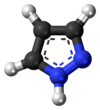Pyrazole
|
|
|||
|
|
|||
| Names | |||
|---|---|---|---|
|
Preferred IUPAC name
1H-Pyrazole
|
|||
| Other names
1,2-Diazole
|
|||
| Identifiers | |||
|
288-13-1 |
|||
| 3D model (Jmol) | Interactive image | ||
| ChEBI |
CHEBI:17241 |
||
| ChEMBL |
ChEMBL15967 |
||
| ChemSpider |
1019 |
||
| DrugBank |
DB02757 |
||
| ECHA InfoCard | 100.005.471 | ||
| KEGG |
C00481 |
||
| PubChem | 1048 | ||
|
|||
|
|||
| Properties | |||
| C3H4N2 | |||
| Molar mass | 68.08 g·mol−1 | ||
| Melting point | 66 to 70 °C (151 to 158 °F; 339 to 343 K) | ||
| Boiling point | 186 to 188 °C (367 to 370 °F; 459 to 461 K) | ||
| Basicity (pKb) | 11.5 | ||
|
Except where otherwise noted, data are given for materials in their standard state (at 25 °C [77 °F], 100 kPa).
|
|||
|
|
|||
| Infobox references | |||
Pyrazole is an organic compound with the formula C3H3N2H. It is a heterocycle characterized by a 5-membered ring of three carbon atoms and two adjacent nitrogen atoms. Pyrazole is a weak base, with pKb 11.5 (pKa of the conjugated acid 2.49 at 25 °C). Pyrazoles are also a class of compounds that have the ring C3N2 with adjacent nitrogen atoms. Notable drugs containing a pyrazole ring are celecoxib (Celebrex) and the anabolic steroid stanozolol.
Pyrazoles are synthesized by the reaction of α,β-unsaturated aldehydes with hydrazine and subsequent dehydrogenation:
Substituted pyrazoles are prepared by condensation of 1,3-diketones with hydrazine. For example, acetylacetone and hydrazine gives 3,5-dimethylpyrazole:
The term pyrazole was given to this class of compounds by German Chemist Ludwig Knorr in 1883. In a classical method developed by German chemist Hans von Pechmann in 1898, pyrazole was synthesized from acetylene and diazomethane.
Pyrazoles react with potassium borohydride to form a class of ligands known as scorpionate. Pyrazole itself reacts with potassium borohydride at high temperatures (~200 °C) to form a tridentate ligand known as Tp ligand:
In medicine, derivatives of pyrazoles are used for their analgesic, antinociceptive, anti-inflammatory, antipyretic, antiarrhythmic, tranquilizing, muscle relaxing, psychoanaleptic, anticonvulsant, monoamineoxidase inhibiting, antidiabetic, antifungal, and antibacterial activities.
...
Wikipedia




